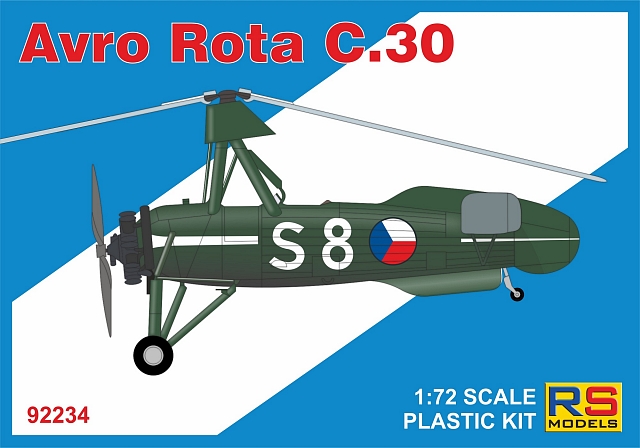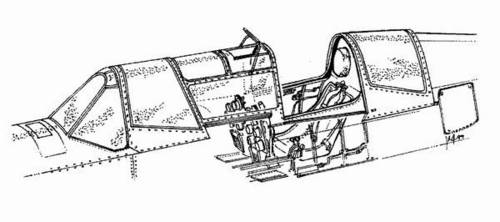Hračky
Celkem 746 produktů
Plastikový model letadla 1/72 Avro Rota C.30A 4 decal v. for Czeczslovak.,RAF, Yugoslavia, Australia. The first production design in the series was the C.30, a radial-engined autogyro with a three-blade, 37 ft (11.3 m) rotor mounted on an aft-leaning tripod, the control column extending into the rear of the two cockpits. The engine was the five-cylinder, 105 hp (78 kW) Armstrong Siddeley Genet Major I used in the C.19 series. The fabric-covered fuselage carried an unbraced tailplane, without elevators but with turned-up tips. The port side of the tailplane had an inverted aerofoil section to counter roll-axis torque produced by the propeller. As with most autogyros, a high vertical tail was precluded by the sagging resting rotor, so the dorsal fin was long and low, extending well aft of the tailplane like a fixed rudder and augmented by a ventral fin. The wide-track undercarriage had a pair of single, wire-braced legs and a small tail wheel was fitted. This model flew in April 1933. It was followed by four improved machines designated C.30P (P here for pre-production) which differed in having a four-legged pyramid rotor mounting and a reinforced undercarriage with three struts per side. The rotor could be folded rearwards for transport. The C.30P used the more powerful (140 hp, 104 kW) seven-cylinder Armstrong Siddeley Genet Major IA radial engine.
Plastikový model letadla 1/72 Avro Rota C.30A 4 decal v. for Czeczslovak.,RAF, Yugoslavia, Australia. The first production design in the series was the C.30, a radial-engined autogyro with a three-blade, 37 ft (11.3 m) rotor mounted on an aft-leaning tripod, the control column extending into the rear of the two cockpits. The engine was the five-cylinder, 105 hp (78 kW) Armstrong Siddeley Genet Major I used in the C.19 series. The fabric-covered fuselage carried an unbraced tailplane, without elevators but with turned-up tips. The port side of the tailplane had an inverted aerofoil section to counter roll-axis torque produced by the propeller. As with most autogyros, a high vertical tail was precluded by the sagging resting rotor, so the dorsal fin was long and low, extending well aft of the tailplane like a fixed rudder and augmented by a ventral fin. The wide-track undercarriage had a pair of single, wire-braced legs and a small tail wheel was fitted. This model flew in April 1933. It was followed by four improved machines designated C.30P (P here for pre-production) which differed in having a four-legged pyramid rotor mounting and a reinforced undercarriage with three struts per side. The rotor could be folded rearwards for transport. The C.30P used the more powerful (140 hp, 104 kW) seven-cylinder Armstrong Siddeley Genet Major IA radial engine.
Plastikový model letadla 1/48 Reggiane Re 2000 I. Serie. Just before the outbreak of WW2, the Reggiane Re 2000 took part in the competition for the standard fighter which was to serve with the Italian air force. Even though the type offered quite high performance, it eventually did not win, so the most of the production was offered for export. The Regia Aeronautica, however, decided to give the type a try and deployed it mainly in the dangerous operations against Malta. The model kit contains four styrene sprues and one with clear parts. The wing sprue has its origins in the Classic Airframes kit while all the other components are brand new, the small ones being produced from metal moulds. Italian WW2 fighter aeroplane three eye-catching marking options bearing the Italian mottle camouflage pattern we also offer separate resin sets and pre-cut masks
Plastikový model letadla 1/48 Reggiane Re 2000 I. Serie. Just before the outbreak of WW2, the Reggiane Re 2000 took part in the competition for the standard fighter which was to serve with the Italian air force. Even though the type offered quite high performance, it eventually did not win, so the most of the production was offered for export. The Regia Aeronautica, however, decided to give the type a try and deployed it mainly in the dangerous operations against Malta. The model kit contains four styrene sprues and one with clear parts. The wing sprue has its origins in the Classic Airframes kit while all the other components are brand new, the small ones being produced from metal moulds. Italian WW2 fighter aeroplane three eye-catching marking options bearing the Italian mottle camouflage pattern we also offer separate resin sets and pre-cut masks




